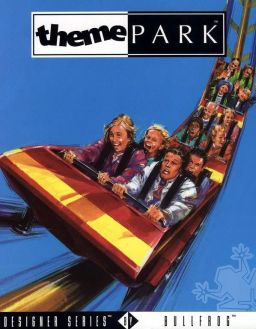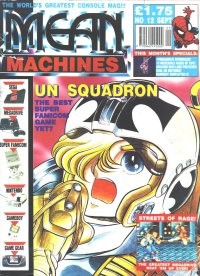
Hexen: Beyond Heretic is a fantasy first-person shooter video game developed by Raven Software and published by id Software distributed through GT Interactive on October 30, 1995. It is the indirect sequel to 1994's Heretic, and the second game in Raven Software's "Serpent Riders" trilogy, which culminated with Hexen II. The title comes from the German noun Hexen, which means "witches", and/or the verb hexen, which means "to cast a spell". Game producer John Romero stated that a third, unreleased game in this series was to be called Hecatomb.

The Nintendo 64 (N64) is a home video game console developed by Nintendo. It was released on June 23, 1996, in Japan; on September 29, 1996, in North America; and on March 1, 1997, in Europe and Australia. The successor to the Super Nintendo Entertainment System, it was the last major home console to use cartridges as its primary storage format until the Nintendo Switch in 2017. As a fifth-generation console, the Nintendo 64 primarily competed with the Sony PlayStation and the Sega Saturn.

The PlayStation is a home video game console developed and marketed by Sony Computer Entertainment. It was released in Japan on 3 December 1994, in North America on 9 September 1995, in Europe on 29 September 1995, and in Australia on 15 November 1995. As a fifth-generation console, the PlayStation primarily competed with the Nintendo 64 and the Sega Saturn.

The 32X is an add-on for the Sega Genesis video game console. Codenamed "Project Mars", it was designed to expand the power of the Genesis and serve as a transitional console into the 32-bit era until the release of the Sega Saturn. The 32X uses its own ROM cartridges and has its own library of games. It was distributed under the name Super 32X in Japan and South Korea, Genesis 32X in North America, Mega 32X in Brazil, and Mega Drive 32X in all other regions.

The Sega Saturn is a home video game console developed by Sega and released on November 22, 1994, in Japan, May 11, 1995, in North America, and July 8, 1995, in Europe. Part of the fifth generation of video game consoles, it is the successor to the successful Genesis. The Saturn has a dual-CPU architecture and eight processors. Its games are in CD-ROM format, including several ports of arcade games and original games.
A killer application is any software that is so necessary or desirable that it proves the core value of some larger technology, such as its host computer hardware, video game console, software platform, or operating system. Consumers would buy the host platform just to access that application, possibly substantially increasing sales of its host platform.

Columns is a match-three puzzle video game released by Sega in 1990. Designed by Jay Geertsen, it was released by Sega for arcades and then ported to several Sega consoles. The game was subsequently ported to home computer platforms, including the Atari ST.
The fifth generation era refers to computer and video games, video game consoles, and handheld gaming consoles dating from approximately October 4, 1993, to March 23, 2006. For home consoles, the best-selling console was the Sony PlayStation, followed by the Nintendo 64, and then the Sega Saturn. The PlayStation also had a redesigned version, the PSone, which was launched on July 7, 2000.

Theme Park is a construction and management simulation video game developed by Bullfrog Productions and published by Electronic Arts in 1994. The player designs and operates an amusement park, with the goal of making money and creating theme parks worldwide. The game is the first instalment in Bullfrog's Theme series and their Designer Series.
The Panasonic M2 is a video game console platform developed by 3DO and then sold to Matsushita, a company known outside Japan by the brand Panasonic. Initially announced as a peripheral chip for the 3DO Interactive Multiplayer, it was later unveiled as a standalone console. The console was cancelled in 1997, but the M2 technology was incorporated into other devices.
1996 saw many sequels and prequels in video games, such as Super Mario 64, Duke Nukem 3D, Street Fighter Alpha 2, Super Mario RPG, King's Field III, Virtua Fighter 3, along with new titles such as Blazing Heroes, NiGHTS into Dreams..., Crash Bandicoot, Pokémon Red/Green/Blue, Resident Evil, Dead or Alive, Quake and Tomb Raider.

Bonanza Bros. is a 3D-style, 2D side-scrolling stealth action game developed and released by Sega in 1990. It is one of the earliest arcade games powered by the Sega System 24 arcade system board. It was ported to various home systems, including the Mega Drive/Genesis, Master System, PC-Engine/TurboGrafx-CD, and several home computers.

Castle of Illusion Starring Mickey Mouse is a 1990 platform game developed and published by Sega and released for the Mega Drive/Genesis. An 8-bit version of the game was later released for the Master System and Game Gear. The game follows Mickey Mouse on a quest to save Minnie Mouse from the evil witch Mizrabel. It is the first game in Sega's Illusion video game series starring Mickey.

Mean Machines was a multi-format video game magazine published between 1990 and 1992 in the United Kingdom.

Valis III is a 1990 action-platform video game originally developed by Laser Soft, published by Telenet Japan and NEC for the TurboGrafx-CD. A Sega Genesis version was released in 1991. It is the third entry in the Valis series. It stars Yuko Asou, a Japanese teenage schoolgirl chosen as the Valis warrior and wielder of the mystical Valis sword after the events of Valis II. King Glames, wielder of the sword Leethus, leads denizens of the dark world to conquer both Vecanti and Earth, seeking refuge for his people amid the destruction of their planet. Together with the demon warrior-maiden Cham and her sister Valna, Yuko must prevent Glames from destroying both worlds. Through the journey, the player explores and searches for items and power-ups while fighting enemies and defeating bosses.

Sega Pro was the first publication from Paragon Publishing and catered for the Sega consoles: the Master System, Game Gear and the Mega Drive. Early editorial staff included Dominic Handy (editor), Les Ellis, Dave Perry (designer), James Scullion and Damian Butt as staff writers. The magazine existed between 1991 and 1996. A German edition of Sega Pro was also published (1992-1994).
In the video game industry, a console war describes the competition between two or more video game console manufacturers in trying to achieve better consumer sales through more advanced console technology, an improved selection of video games, and general marketing around their consoles. While console manufacturers are generally always trying to out-perform other manufacturers in sales, these console wars engage in more direct tactics to compare their offerings directly against their competitors or to disparage the competition in contrast to their own, and thus the marketing efforts have tended to escalate in back-and-forth pushes.











